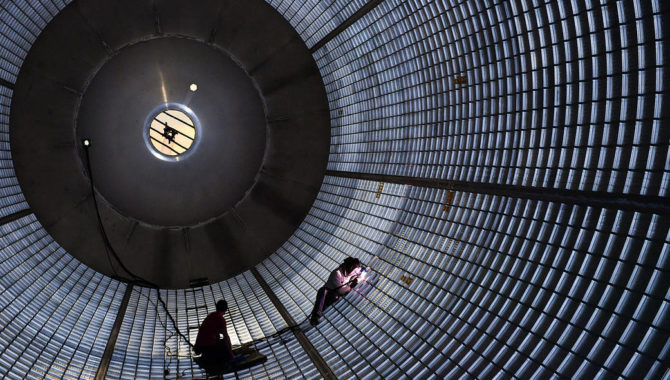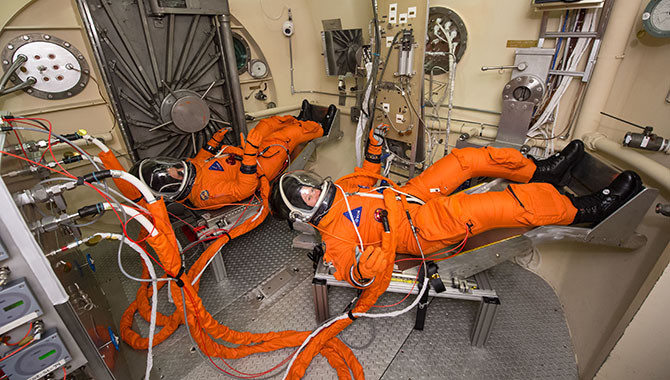
NASA is developing the world’s most powerful launch vehicle, the Space Launch System (SLS), to enable crewed missions to deep space. In this image, welders plug holes in a large liquid hydrogen tank for the SLS, using a technique that produces high-strength bonds that are essentially free of defects.
Photo Credit: NASA/Michoud/Steve Seipel
According to NASA Administrator Charlie Bolden, “Space is hard.” Hardest of all may be the question of how to address ethical issues and risk involved in human spaceflight.
At a meeting of the American Society for Bioethics & Humanities last year, Bolden said, “As we embark on a future in which we’re seeking to push out farther into the solar system, I’d argue that the toughest decisions we will face will not be technical (although make no mistake, those decisions are tough). They won’t be budgetary (although those decisions are tough, too). They won’t even be legal or political. In my mind, the toughest decisions we will have to make will be ethical.”
The ethics of space exploration touch on diverse topics, such as avoiding biologic contamination of other worlds. Closer to home, a core concern involves how to identify and mitigate risks to astronauts, both during and after their missions. Some risks center around the dynamics of launch, the harsh environment of space, and the challenges of reentry. Other risks are related to the effects of microgravity on human physiology, such as shifts in cardiovascular function, visual acuity, bone density, and muscle mass. Radiation exposure elevates cancer risk, while astronauts also face hazards stemming from the closed environments of spacecraft and space stations where both air and water are recirculated, leading to potential contamination and chemical accumulation despite the use of purification systems.
To mitigate risk, NASA engages in a range of activities designed to support the health of crew in space and back on Earth. Findings from the recent One-Year Mission—in which NASA astronaut Scott Kelly and Russian cosmonaut Mikhail Kornienko spent 12 months on the International Space Station (ISS)—are helping expand understanding of the effects of prolonged weightlessness on the human body. On the ground, NASA works with the National Academies of Sciences, Engineering, and Medicine to assess evidence reports concerning a wide range of potential risks to astronauts during long-duration missions. In addition, NASA and the National Academies have established methods for determining guidelines for exposure to radiation, air contaminants, and spacecraft water.
As the agency moves forward on the journey to Mars, which will entail longer-duration crewed missions than undertaken previously, more comprehensive data are needed on the health impact of spaceflight. This data will enable NASA to adequately plan for future missions as well as to ensure astronauts returning from these missions receive appropriate care. To that end, a June 2016 House of Representatives Subcommittee on Space hearing was held concerning the need for funding that would allow NASA to further assess the health effects of spaceflight on current and former astronauts. Participants included several astronauts as well as experts on crew health and spaceflight ethics.
Speaking at the hearing, NASA Chief Health and Medical Officer Dr. Richard Williams explained that, like members of the U.S. military, astronauts face occupational risks. However, Williams said, “the spaceflight environment includes hazards/stressors that are unique and whose effects on humans are not well understood, due largely to the limited data set generated during the relatively short time that humans have been flying extended missions in space.”
Each year, NASA expands that data set though the Lifetime Surveillance of Astronaut Health (LSAH) Program, which invites former astronauts to receive annual health status evaluations at Johnson Space Center (JSC). Roughly 60% of living astronauts participate in the voluntary program. Unlike members of the military, astronauts are not entitled to government-sponsored lifetime health care. Therefore, after an LSAH evaluation NASA can recommend follow up for any apparent concerns, but that follow up must be conducted by the astronaut’s personal physician, who likely has no understanding of space-related health issues.
“[T]he inability to perform more extensive medical evaluations limits NASA’s understanding of conditions that may not surface until years or even decades after exposure to space. Expanding the tests and conditions NASA can proactively monitor would greatly assist in establishing the evidence base we need. It would also increase the numbers of astronauts who participate,” said Chris Cassidy, NASA Chief Astronaut.
Reports from the Health and Medicine Division of the National Academies recommend changes in policy regarding lifetime health care for astronauts. Jeffrey Kahn, professor at the Johns Hopkins Berman Institute of Bioethics and chair of the National Academies’ Committee on Ethics Principles and Guidelines for Health Standards for Long Duration and Exploration Spaceflights, discussed his committee’s perspective at the hearing.
“An important ethical challenge of exposing humans to the risks of long duration and exploration spaceflight is that the burden of the health risks associated with these missions falls to a limited number of astronauts and their families while the benefits of the proposed missions accrue primarily to future astronauts and to society more broadly,” Kahn said. He added, “[T]he committee maintained that the nation, through NASA, has the ethical duties to protect and sustain astronauts’ health.”
A focus on the ethics of human spaceflight and appropriate astronaut care is particularly relevant as interest in becoming an astronaut reaches an all-time high: NASA’s 2017 astronaut class received more applications than any previous class. On a practical level, more crew will be needed as the commercial industry assumes responsibility for activities in low Earth orbit (LEO) while NASA focuses on sending humans farther into deep space than ever before. This combination of interest and demand underscores the need for NASA to be able to provide adequate care and collect long-term data on the risks associated with human spaceflight. That data will support the well-being of current and future generations of astronauts and enable mission planners to better mitigate risk.
Kelly, now retired from NASA, emphasized this point at the Subcommittee on Space hearing. “If we are to go beyond low Earth orbit, NASA needs the ability to proactively and aggressively monitor, diagnose, and treat astronauts who serve our country in the name of science and exploration. Expanding healthcare coverage for our U.S. astronaut corps will enable NASA to more effectively and efficiently support it and collect the data necessary to push out further into our solar system,” he said.
Kelly’s statement echoed the NASA administrator’s words to the American Society for Bioethics & Humanities. “An undertaking such as a journey to Mars will necessitate a lot of big ethical choices,” Bolden said. “For starters, there’s the question of whether we’re willing to put the lives of human beings at risk, not just for the duration of the mission, but for afterwards by putting their post-flight quality of life into question.”
He added, “I think everyone who has been to space would say it’s worth the risk. Sailors suffered from scurvy until a solution was found. Pilots flying at high altitudes have had to make adjustments for extreme cold and lack of oxygen. Astronauts have had to endure unplanned extensions to their space missions due to human and natural events. But no one has ever experienced anything like a multi-year, round-trip spaceflight to Mars.”
As more data become available and more questions are answered, the agency will be increasingly well equipped to push farther into space while mitigating risk for the men and women who lead the way to LEO and beyond.









